My senior year in high school, I played Respighi’s ‘Pines of Rome’ with the Elgin Youth Symphony Orchestra. The music I played 6 or 7 years ago was still vivid in my mind as I accompanied the senior class of BFA to Rome. Though I am now miles away from Elgin, the music which once drew my imagination to faraway lands continues to play in my mind as I cross the threshold of imagination into real, solid places, separated by the mere veil of time from the history I once pictured.
Throughout the week, I noticed the wonderful aroma of the pines surrounding every major sight. It was easy to see why Respighi was so inspired by these majestic trees dotting the ancient ruins of the once-great city.
The first movement of Respighi’s work is called Pines of the Villa Borghese. While we didn’t actually visit the upper-class village (Borghese means Bourgeois, or upper class), we did visit the Ostia Antica, which is a set of ruins of an entire city. As we walked by ancient homes, I could almost hear the games of ancient Roman children playing outside with birds calling to one another in the pines above. It was quite funny – I took a break from walking around and just rested on the ground, looking up at the trees. I could hear some distinctive bird calls, and they may have been some of the same ones Respighi imagined for this movement!

Our own kids playing under the pines (with fellow sponsors Valerie and Jill supervising the mischief)
The second movement is Pines of the Catacombs. We had the privilege of visiting the largest catacombs. It was a moving experience. It was started with two Roman soldier martyrs. Early Christians used to meet in the catacombs because they were underground and therefore safer to conceal their worship when it was illegal to be a Christian. They were not, however, used as hiding places. The atmosphere was somewhat somber, as Respighi depicts in his composition. Yet for the early church, it was a place of hope. They were anticipating resurrection; in fact, catacombs were called dormitories because the inhabitants were only “sleeping.”
The third movement is called Pines of the Janiculum. The Gianicolo is a hill with a temple for a Roman god Janus. Though we did not go there on the Rome trip, we did see the Pantheon. Romans collected various gods and worshiped them all in this temple. They added Jesus as one of the gods to be worshiped, but eventually the Catholic church made it into a basilica. The architecture of the building is fascinating – perfectly cubic dimensions, with a half sphere from the inside. It has quite a different history than the catacombs!
At the triumphal arches, my thoughts were drawn to the compelling 4th movement – Pines of the Appian Way. I could almost hear the moans of the slaves and the trumpets of the victorious Romans as I walked down the pine-lined road toward the arch. This arch was right next to the Colosseum.
When an emperor went out conquering other people, he would take a bunch of spoil and slaves. He and his generals would parade the conquered slaves into town with incense, cheering, trumpets, and a good ole’ hullabaloo.
Paul mentioned the triumphal procession in relation to our standing with God. 2 Corinthians 2:14 says, “But thanks be to God, who in Christ always leads us in triumphal procession, and through us spreads the fragrance of the knowledge of him everywhere.”
So basically, God is the great emperor who went out and conquered our nation. We as people can fall on two sides – those slaves who are going to be put to death as part of the victorious celebration of Christ’s victory, or those who share in His victory. That can either be a pleasing aroma or the stench of death.

For we are the aroma of Christ to God among those who are being saved and among those who are perishing.
There is much more to tell about the Rome trip, but for right now I need to get some sleep!







